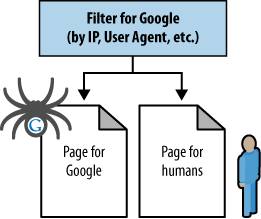Content Delivery and Search Spider Control
On occasion, it can be valuable to show search engines one version of content and show humans a different version. This is technically called cloaking, and the search engines’ guidelines have near-universal policies restricting this. In practice, many websites, large and small, appear to use content delivery effectively and without being penalized by the search engines. However, use great care if you implement these techniques, and know the risks that you are taking.
Cloaking and Segmenting Content Delivery
Before we discuss the risks and potential benefits of cloaking-based practices, take a look at Figure 6-30, which shows an illustration of how cloaking works.

Figure 6-30. How cloaking works
Google’s Matt Cutts, head of Google’s webspam team, has made strong public statements indicating that all forms of cloaking (other than First Click Free) are subject to penalty. This was also largely backed by statements by Google’s John Mueller in a May 2009 interview, which you can read at http://www.stonetemple.com/articles/interview-john-mueller.shtml.
Google makes its policy pretty clear in its Guidelines on Cloaking (http://www.google.com/support/webmasters/bin/answer.py?hl=en&answer=66355):
Serving up different results based on user agent may cause your site to be perceived as deceptive and removed from the Google index.
There are two critical pieces ...
Get The Art of SEO now with the O’Reilly learning platform.
O’Reilly members experience books, live events, courses curated by job role, and more from O’Reilly and nearly 200 top publishers.

